Lea Wait's Blog, page 46
January 30, 2024
Coming Attractions! What’s Ahead in 2024
Kate Flora: New Year’s has passed, and we’re hard at work in the New Year. We thought we’d take this opportunity to share some of the books we’ll publish in 2024, and projects we’re working on that haven’t yet found a home. As for me? I don’t have anything in the pipeline yet, but hope that in the months ahead, Unleashed Love, my romantic tale about a matchmaking dog, will find a home. I’m also hopeful about a thriller currently titled The Senator’s Daughter, although I hope to find a better title with the help of my Facebook friends. Now it’s back to work on the next Joe Burgess, although I’m getting pressure to write a new Thea as well. We shall see. Inspiration has a way of sidetracking the best laid plans. Who knows? It might a children’s book, cowritten with my cousin, about a car nut named Ben and a mouse named Carby. Stay tuned.
 Kaitlyn Dunnett/Kathy Lynn Emerson: Continuing a “retirement” project I started last year, I’m turning the last of my romance novels published in the years 1989-1997 into an omnibus e-book (and possibly a print-on-demand trade paperback as well, if it doesn’t end up being too expensive). These books needed some revising, not to set them in the present day, but rather to get rid of the worst of the wordiness, some rather purple prose, and a few cringeworthy lines of dialogue from my “heroes.” This collection, titled The Maine Quartet, should be ready for me to publish through Draft2Digital sometime in February. Along with the four novels set in Maine, it will also contain a bonus short story, “The Boston Post Cane.” When that’s done, I have more reprint projects in mind. I want to do a thorough revision of an early historical romance, Firebrand, and bring it out as a “new” novel with a new title (probably Treacherous Gifts). I did this last year with another title, turning Winter Tapestry, a romance, into Death of an Intelligence Gatherer, a mystery. I’m also toying with the idea of producing new print-on-demand editions of my entire Face Down series, set in the 16th century. I already did the hard part on those when I collected them into three volumes for new e-book editions.
Kaitlyn Dunnett/Kathy Lynn Emerson: Continuing a “retirement” project I started last year, I’m turning the last of my romance novels published in the years 1989-1997 into an omnibus e-book (and possibly a print-on-demand trade paperback as well, if it doesn’t end up being too expensive). These books needed some revising, not to set them in the present day, but rather to get rid of the worst of the wordiness, some rather purple prose, and a few cringeworthy lines of dialogue from my “heroes.” This collection, titled The Maine Quartet, should be ready for me to publish through Draft2Digital sometime in February. Along with the four novels set in Maine, it will also contain a bonus short story, “The Boston Post Cane.” When that’s done, I have more reprint projects in mind. I want to do a thorough revision of an early historical romance, Firebrand, and bring it out as a “new” novel with a new title (probably Treacherous Gifts). I did this last year with another title, turning Winter Tapestry, a romance, into Death of an Intelligence Gatherer, a mystery. I’m also toying with the idea of producing new print-on-demand editions of my entire Face Down series, set in the 16th century. I already did the hard part on those when I collected them into three volumes for new e-book editions.
Maggie Robinson: If I ever finish editing, I hope to release two 1920s-set cozy mysteries into the 2020s–Lady May and the Memoir of Death, and Lady May and the Master of Deceit. The heroine is a woman “of a certain age” and quite close to my heart. The series also features a Scotland Yard detective anxious to retire, Lady May’s widowed niece Lady Alice, Lady Alice’s three-year-old son Tommy, a disreputable dog, and several dead bodies. Something for everyone! And I’ll continue to plug away on my turn-of-the-20th-century Maine island murder mystery.

Matt Cost: I have two books slated for publication this year. Pirate Trap will pub on March 27th. It is the fifth book in the Clay Wolfe/Port Essex Trap series. Clay and Baylee are hired to search for a long lost treasure and things immediately get more complicated. Pirates, motorcycle gangs, and sex doll manufacturers round out the mix. City Gone Askew will pub on July 31st. It is the second book in the Brooklyn 8 Ballo series. 8 Ballo is hired to investigate a death, a missing Roman Legion Standard, and gets drawn into investigating shady practices being run by Carnegie Institute regarding the eugenics movement in 1924 Brooklyn. The sixth book in the Goff Langdon Mainely Mystery series, Mainely Mayhem, is done and awaiting a pub date, which may be fall of this year, or spring of next. Write on.

Jule Selbo: 8 DAYS, A Dee Rommel Mystery has been out for 6 weeks now and reviews (from Kirkus to the LA Times Book Review to other sites/blurbs and Amazon reviews) have been great and I am so grateful. BUT!!! A hundred pages into 7 DAYS now, that familiar fear is setting in. Will I be able to make this work as well at 8 DAYS? And 9 DAYS and 10 DAYS – the other Dee Rommel Mysteries.
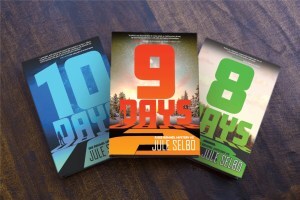
Last Saturday I spent a few hours at the Waldoboro Library talking with mystery readers (and readers of other genres) about writing and characters in my books. They braved the cold, were served tea and we had a fabulous time in the beautiful space. The energetic Ann Leamon (lead at Waldoboro Library – and non-fiction writer) put the event together and she’s planning on doing more of these in the future.



The attendees were interested in mysteries and historical fiction so I got to talk about Dee Rommel as well as my mystery/romance that takes place in Florence Italy and the two historical fiction biographies I’ve written.
I am doing some book clubs in the Portland/Yarmouth/Falmouth area soon and an event in Freeport in April that I’m looking forward to also – I’ve heard that group of readers are voracious! LOVE the SNOW, LOVE the COLD. HAPPY JANUARY!
John Clark: I’m part of two critique groups, one in person, one on Zoom. They are giving me valuable feedback on (I’m Not) Singing the L.A. Blues and Thor’s Wingman, both YA novels with paranormal and mystery themes. I have an historical short mystery story to submit for this year’s competition. I plan to go back to the twenty story starts I posted in two MCW blog posts (one recently, one in 2022), and turn as many as are practical into short stories. Already, two became full length books and another a Christmas story that was posted on YA Outside The Lines. Stay tuned for progress reports.
Maureen Milliken: I’ve got some exciting news for a change. At least, exciting for me.
The publisher of my three-book Bernie O’Dea series is ramping down operations, and handed back the rights to the books (short version), and I’ve taken the opportunity to republish under my own imprint, Nevermore Mystery Press. Look forward in the coming months to posts on how that all works.
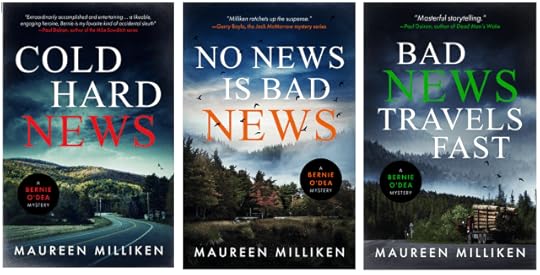 I wasn’t ready to give up on the series, and readers certainly aren’t. I frequently get asked when the fourth book is coming out, and I can say with confidence that DYING FOR NEWS will be out this summer.
I wasn’t ready to give up on the series, and readers certainly aren’t. I frequently get asked when the fourth book is coming out, and I can say with confidence that DYING FOR NEWS will be out this summer.
In the meantime, the first three books in the series, COLD HARD NEWS, NO NEWS IS BAD NEWS and BAD NEWS TRAVELS FAST have all been republished with new covers, new edits and some updated writing. I am very excited about the new versions — both the look and the content. (Another post for another day: The importance of finding a cover designer you really like, communicating with them and committing to pay for covers that will help your books sell and that you can be proud of).
I published on IngramSpark, as well as Amazon KDP, and that, too, will be a post for another day. Another post for another day will be the vagaries of republishing already published books on Amazon, with new ISBNs (required since the old ones belonged to my publisher), which is not going as smoothly as I hoped.
I will say this about it, though: the COLD HARD NEWS print edition is somehow attached to the old version, which normally would be great, since that means the reviews are still there, but it’s not visible to anyone but me since the old version has been unpublished.
On the other hand the COLD HARD NEWS ebook, as well as the two other books are easily found, but have no reviews.
Which brings me to: Anyone who is willing to do an honest Amazon review is welcome to a free ebook or print version of any of the three books (though with CHN just an ebook, since I don’t know how that’ll work right now with the print version). Please contact me at mmilliken47@gmail.com or through the contact form on my website, maureenmilliken.com if you are interested. I will gift you an ebook, or be happy to ship you a print version.
Aside from all this blah blah blah, I’ve very excited about DYING FOR NEWS and getting back to the series. I’ve put aside the non-series book I’ve been slowly laboring over for several years, but that’s still in the works at some point, too.
January 29, 2024
Piracy – It’s not just a seafaring pursuit these days
 Welcome to 2024—it’s surreal. Remember all the year 2000 hype and fears. We wondered what would happen to our computers as the millennium clock struck midnight. Would they self-destruct? Turn into expensive paperweights? What about things that really mattered? You know, nuclear warheads and their launch codes. Looking back now, it seems anticlimactic. I had a DOS run computer (black background, orange tree) that reset itself to 1/1/1900, but other than remembering to manually date my documents, nothing else happened. Just in case, I’d backed up all my documents on 5.25” floppies, with an additional backup on 3.5” floppies. I come from a legal background. Belt, suspenders.
Welcome to 2024—it’s surreal. Remember all the year 2000 hype and fears. We wondered what would happen to our computers as the millennium clock struck midnight. Would they self-destruct? Turn into expensive paperweights? What about things that really mattered? You know, nuclear warheads and their launch codes. Looking back now, it seems anticlimactic. I had a DOS run computer (black background, orange tree) that reset itself to 1/1/1900, but other than remembering to manually date my documents, nothing else happened. Just in case, I’d backed up all my documents on 5.25” floppies, with an additional backup on 3.5” floppies. I come from a legal background. Belt, suspenders.
As we enter 2024, a different technical controversy rages. AI—artificial intelligence, or as my husband refers to it, artificial ignorance—sometimes I think he’s spot on. While I don’t have a handle on the technical aspects of AI, I know it needs to be trained. To train it, developers are feeding the programs published books. Most obtained from pirate sources. Piracy has been an issue for authors for years. Needless to say, authors receive no royalty from the pirated books. Nor do they for works used to train AI. The Author’s Guild discussed this matter in September. They also included a link to a website with a partial list of pirated books. You can read the article here.
Amazon has begun asking if any part of an indie author’s book, including the book

Photo by Igor Omilaev via Unsplash
description, is AI generated. They are not refusing to publish AI written books, but they are collecting the information. They exclude spelling and grammar checking programs from the query, although some of the more popular ones offer a “suggested revision” function. Whether or not that constitutes using AI is left to the discretion of the author.
This controversy led me to look at the writing programs I use. Plottr, Scrivener, ProWritingAid, and Atticus are in my common use arsenal. Of the four, only ProWritingAid offers features beyond spellcheck. It has recently introduced a suggested revision function. As a lark, I dropped a blog into the program and allowed it to suggest revisions to my work. The suggestions were stilted to the point of sounding like 1960s robot speak, or downright funny. I’m sure they will improve over time.
It’s a brave new world out there. Whether to use AI is a decision every author will have to make on their own. It’s not for me. I love the creative process too much, and I vigorously object to purloining someone’s hard-earned words for use as a free training aid. Others may have different opinions, or may decide that AI has a place in their plotting or outlining process. To quote Alice, “Curiouser and curiouser.” All options are open.
January 26, 2024
Weekend Update: January 27-28, 2024
 Next week at Maine Crime Writers there will be posts by Kait Carson (Monday), the MCW group (Tuesday), Kaitlyn Dunnett/Kathy Lynn Emerson (Thursday) and Kate Flora (Friday).
Next week at Maine Crime Writers there will be posts by Kait Carson (Monday), the MCW group (Tuesday), Kaitlyn Dunnett/Kathy Lynn Emerson (Thursday) and Kate Flora (Friday).
In the news department, here’s what’s happening with some of us who blog regularly at Maine Crime Writers:
An invitation to readers of this blog: Do you have news relating to Maine, Crime, or Writing? We’d love to hear from you. Just comment below to share.
And a reminder: If your library, school, or organization is looking for a speaker, we are often available to talk about the writing process, research, where we get our ideas, and other mysteries of the business, along with the very popular “Making a Mystery” with audience participation, and “Casting Call: How We Staff Our Mysteries.” We also do programs on Zoom. Contact Kate Flora
Storms, Real and Imagined
Charlene D’Avanzo: I live on an island (Little John) in Yarmouth connected to the  mainland by several bridges. Despite the ocean all around us, being island bound hasn’t been an issue because the bridges hadn’t flooded since we’ve lived here. That changed during the storm last week when we lost power.
mainland by several bridges. Despite the ocean all around us, being island bound hasn’t been an issue because the bridges hadn’t flooded since we’ve lived here. That changed during the storm last week when we lost power.
We and our neighbors weren’t worried – in fact half the island wandered down to the water to watch waves splash up and over the bridge. Without electricity I guess the bridge spectacle was the only diversion available.
The next day Maine Department of Transportation came to our rescue and cleared the bridge. Our incident was minor but it got me thinking about the power of ocean storms – and some terrific books that tell the story. Here are a few:
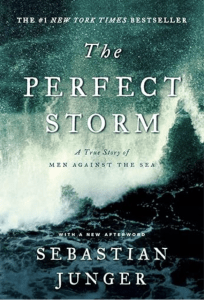 The Perfect Storm: A True Story of Men Against the Sea: Readers may recall this creative nonfiction bestseller about the so-called perfect storm – a rare combination of storm systems. The fishing vessel Andrea Gail, from Gloucester Massachusetts, was lost and all six crew members presumed dead. In 2000, the book was adapted into a movie starring George Clooney.
The Perfect Storm: A True Story of Men Against the Sea: Readers may recall this creative nonfiction bestseller about the so-called perfect storm – a rare combination of storm systems. The fishing vessel Andrea Gail, from Gloucester Massachusetts, was lost and all six crew members presumed dead. In 2000, the book was adapted into a movie starring George Clooney.
The Tempest by William Shakespeare: The storm that shipwrecks Prospero and Miranda sets the scene for the action of the play on the island. This ambitious and imaginative story is about magic, family, power, and race.
Northeaster: A Story of Courage and Survival in the Blizzard of 1952: A vivid and gripping story of an epic Maine snowstorm that tested the very limits of human endurance.
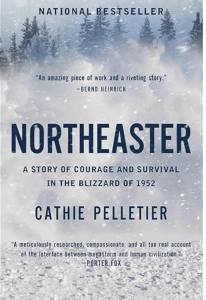 Storm Watchers is a terrific journey about the evolution of weather forecasting. From the age when meteorology was considered akin to sorcery to modern-day wizardry of supercomputers, John Cox introduces pioneering scientists whose work made it possible to foretell the future. He tells little-known stories of weathermen such as Ptolemy’s weather predictions based on astrology, John Finley’s breakthrough research identifying tornadoes, and Tor Bergeron’s new weather forecasting techniques which contributed to its final worldwide acceptance.
Storm Watchers is a terrific journey about the evolution of weather forecasting. From the age when meteorology was considered akin to sorcery to modern-day wizardry of supercomputers, John Cox introduces pioneering scientists whose work made it possible to foretell the future. He tells little-known stories of weathermen such as Ptolemy’s weather predictions based on astrology, John Finley’s breakthrough research identifying tornadoes, and Tor Bergeron’s new weather forecasting techniques which contributed to its final worldwide acceptance.
 Filled with extraordinary tales of bravery and sacrifice, Storm Watchers will make you think twice the next time you turn on the local news to catch the weather report.
Filled with extraordinary tales of bravery and sacrifice, Storm Watchers will make you think twice the next time you turn on the local news to catch the weather report.
January 25, 2024
PIRATES IN MAINE!
Dixey (or Dixie) Bull is generally considered the first pirate in Maine. As these things so often go, even if he dreamed of being a pirate when he was a kid, living the life of a buccaneer of the seas was not his first intention. But, given his moniker, perhaps becoming a corsair was merely his manifest destiny.
In the early 17th century, Bull started life off as an honest merchant, but when a roving band of French men attacked him along the coast of Maine, moored in Penobscot Bay, and relieved him of trade items of knives and beads as well as the furs he was bartering them for, something clicked in his brain. The raiders left him his small sailing vessel, but nothing else.
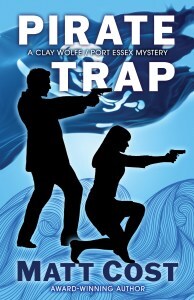
Destitute and desperate he visited several English settlements and recruited fifteen men to be in his band of pirates. They started out ransacking small vessels, expanded their treachery to settlements along the coast, and then The Dread Dixey Bull and crew disappeared into thin air, never to be heard from again.

Almost one hundred years later we come across Black Sam Bellamy. Much like Bull, Bellamy started off as a sailor, but he was with the British Royal Navy. Stationed in Cape Cod, he’d fall in love with a young lass named Goody Hallett. It is not quite known whether she was already married, and her husband disapproved (funny that), or she was too young, and her parents rejected Bellamy, but either way, he felt it necessary to go find his fortune so that he could return and take Goody away.

He initially went looking for the treasure of the Lost Spanish Armada of 1715, but when that didn’t work out, he turned to piracy. In a little over a year, he became the wealthiest pirate ever, capturing the loot for up to fifty-three different ships.
And this is where it becomes interesting. Loaded down with loot, he came to Maine. He stopped in Pemaquid Point before continuing to Machiasport with the thought of creating a Pirate Utopia, a democratic community of buccaneers enjoying the splendors of their booty. He had one task left to do first, though, and that was to retrieve his love, Goody Hallett, from Cape Cod.
Unfortunately, his ship was caught in a fierce storm and sunk, and he and all but two of his men went down with the ship.

And this is where my latest Clay Wolfe adventure begins. One of those survivors carries with him a treasure map that suggests that the stolen riches of Black Sam Bellamy were actually buried/hidden in the area now known as Port Essex. This map is uncovered in a King James Bible by two antique dealers who hire Clay and Baylee to help them find the treasure.

Of course, it is not that simple. Pirates, Motorcycle Clubs, and Sex Doll Manufacturers round out the mix of those hunting the treasure.
Pirate Trap publishes March 27th. Dead men tell no tales. Or do they?
About the Author
Matt Cost was a history major at Trinity College. He owned a mystery bookstore, a video store, and a gym, before serving a ten-year sentence as a junior high school teacher. In 2014 he was released and began writing. And that’s what he does. He writes histories and mysteries.
Cost has published five books in the Mainely Mystery series, with the fifth, Mainely Wicked, just released in August of 2023. He has also published four books in the Clay Wolfe Trap series, with the fifth, Pirate Trap, due out March 27th, 2024.
For historical novels, Cost has published At Every Hazard and its sequel, Love in a Time of Hate, as well as I am Cuba. In April of 2023, Cost combined his love of histories and mysteries into a historical PI mystery set in 1923 Brooklyn, Velma Gone Awry. City Gone Askew will follow in July of 2024.
Cost now lives in Brunswick, Maine, with his wife, Harper. There are four grown children: Brittany, Pearson, Miranda, and Ryan. A chocolate Lab and a basset hound round out the mix. He now spends his days at the computer, writing.
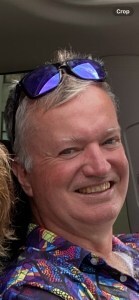
January 22, 2024
Character is King? Or Consort?
Sitting here with a toothache eating up one side of my face and wondering why ibuprofen gives me such stellar dreams, unless it was the combination of CBD gummies and Pinot Noir I tried before giving in to the chemical help. And partly because of the people in those dreams—such details you don’t want to know—I’ve been thinking about how I create characters.
The smartass response to the question “Where do you get your characters?” is the same as the smartass answer to the “Where do you get your ideas?” question, beloved of readers and other people at writer events. Why, from the idea store, of course. Why, from the character store, of course.
But flippancy aside— blame the gummies—there are all kinds of ways a writer goes about creating characters.
blame the gummies—there are all kinds of ways a writer goes about creating characters.
Some people use actual templates to build a character. I had a student once who wrote out a three-page list of personal history, physical, emotional, and behavioral characteristics she would have to know before she felt as if she could write a character well enough. I have a hard enough time writing a one page synopsis for my editor—if I did that much thinking for each of the ten to fifteen characters in a new book, I would feel as if I had already squeezed all the juice out of them. No more surprises left. And I need surprises when I’m writing.
That’s probably the most extreme example of using prework to build a character. My style, unsurprisingly to me, is somewhat lazier.
My characters emerge slowly from the actual writing of the story I’m working with. My writing process, if that’s not too definitive a word for it, is to write many (7 to x) drafts of a novel from start to finish, the whole thing at once. (I’m not one of those fortunate souls who can write parts and pieces out of order and stitch them all together later. I’d be too worried the stitching would show.)
In the course of each draft, the characters (always assuming I’m not working in a series where I understand something of the recurring characters already) emerge gradually from the layering of incident, description, dialogue, and narrative, exposing themselves through their participation in the story as it unfolds. On the fly. (Because I don’t write outlines, either.)
So the book, the story, ideally, deepens and widens with each draft and the characters emerge more fully through each subsequent iteration. Which is not to say I have no idea who a character is when I start.
For example, the core of the character of Ardmore Theberge in The Last Altruist
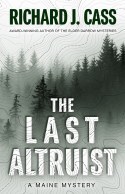
came to me from the story of Eddie Gallagher, the Navy SEAL who was charged with fatally stabbing an injured 17-year-old ISIS prisoner, photographing himself with the corpse, and sending the photo to friends. Half his military unit tried to pretend it hadn’t happened; half tried to see that he was brought to justice.
I started out to wonder what a man, a fellow soldier who stopped someone from doing something like what Gallagher was accused of and paid the military and personal price, would be like. So the central fact of that character was that he had protected the dead man. Through the book, as it developed, it became clear that Theberge was taking on the role of protector of all, of friends and lovers and all the other people he encountered who were less able to take care of themselves. But I didn’t have a clear idea how that one central notion would round into his character until I wrote the book, again and again.
The obvious benefit to doing it this way is that the action of the story and the description of the characters integrate as the story unfolds. I know as I’m going along whether a character would do what the story is trying to make him do or if I have something wrong in the narrative. Writing the story whole brings an integrity of character and action.
Names are important. I find it hard to name characters in advance. In the same way their characteristics rise from the writing, a name has to be consistent with the character. This means the character has to develop a little first before I know his or her name. In the Elder Darrow series, I only came to his name after writing enough of the first book to realize I needed the character to be part of an old-line New England family. The name had to have the flavor of both history and New England Brahmin origins. “Elder” harks to the names of the old Yankee preachers; “Darrow” has the four-square feel of a Mayflower-family name. And so on.
But, I admit, there are oodles of ways to skin a felis.
If I could wish for another way to build characters, I think I would wish for a more visual method. I know writers who see their characters (in their heads, obviously) and it seems that would confer a very big advantage in rendering them, describing them at least. But, as

Popeye says, I yam what I yam. And I’ll have to deal with that part of my character.
January 21, 2024
Ooops. “Ass At Own Risk.” Details Too Good to Waste
Sandra Neily here:
I collect details that I migrate to my characters, plots and pages. (My pockets and car corners are full of errant slips of paper.)
Today I thought I’d share some of the list that’s taped next to me. Right in front of my face as I work so it’s hard to avoid.  Yes, it’s typed but as the pages accumulate, there’s lots of scrawled notes too: snatches of conversations I might hear or how someone’s dressed. (On the coldest day recently, I stood in line at the post office with a woman in a down parka and flip flops. Bare feet).
Yes, it’s typed but as the pages accumulate, there’s lots of scrawled notes too: snatches of conversations I might hear or how someone’s dressed. (On the coldest day recently, I stood in line at the post office with a woman in a down parka and flip flops. Bare feet).
I add signs found in windows, bumper stickers, intriguing or bad behavior. (Like an “Ass at Own Risk” sign missing its opening P.)
In Quebec last summer at small, public park, a Cadillac convertible showed up with a couple who looked to be in their thirties. They sat two picnic tables away and let their dog roam. Near our tables, the dog took a huge dump next to the bathroom walkway. The couple ate their lunch. They called the dog. They left his steaming pile.
The scene was too good to waste. I will use it as a way to quickly define (or degrade) a character.
*****************************
Maybe something from my list will jog a memory that should not be wasted or a sharp detail that will bring even more life to your stories.
One strand of hair is placed on a table and someone says, “It’s barely this side of legal.”
“septic” “prehistoric” One word uttered as complete conversation.
camp: “safest place on earth”
Gate torn off and dragged to bar in town (ATV’s go anywhere; can’t stop them w barriers)
Hair spray’s weird uses
Hates rap: just more men in your face
Shreds an Evan (ex) picture; one remaining eye stares from waste basket.
Contact lenses: dried up like cornflakes, swallowed when sucked for cleaning, whipped out by wind.
Consignment store rejects her clothes (suits) as too “dated” for resale.
Arthritis anger: packaging as the enemy. Uses hammer to smash lid off
New car smell fights w beef bones odor (free bones for dog; she uses for cheap soup)
Irony: outdoors make us more human
“People who can be very good can be very bad too.”

trail camera on tree
Pees without seeing cameras on trees
Subaru is her undercover mailbox; anonymous tough stuff left there
Trapped, iced-in loon. Spring that isn’t spring. Young warden w a tub rescue
Always P’s outlaw choices. “If wilderness is outlawed, only outlaws can save wilderness …. God bless America. Let’s save some of it.” Edward Abbey
Leash dragging, dog leaps into the car at a run
“Grief dares us to love once more…” Terry Tempest Williams
Pock sniffs out salamanders
Moving through the woods is “healing” activity.
The pain of bad things rubbing together
Moz: “bright shining wet stones from a river eyes”
Sally’s coywolf: intense hungry look. Not normal coyote. Swimming nude, literally naked prey.
Dig daffodils from snow. Fragility.
The Big Nothing (endless woods): developers’ narrow perspective.
Pock; tug of war always at wrong times
Patton: fearful after chemo; cries out over small hurts (almost a keening)
Road names: developers use what’s displaced: Fox Run, Otter Slide
Millie: glitter green glasses; Françoise, purple anything esp. tights
Owl calling; spring mating
Pishing sounds: Patton calls in birds

If land is not posted, in Maine, you can go there. We are so lucky.
Permissive Trespass (a go anywhere in ME thing)
Patton’s still gray skin in selfie, compared w Kate
Cold weather fishing: back cast freezes in air
Chicken skin pulled off with teeth

restuff and sew
Sewing up wrecked dog toys
Hot tea bag for washing face
“I will not be silenced by intimidation or grief.” TT Williams (The struggle to be heard)
Ex husband. Revenge. Poke tiny holes w pin in his raft; gets limp slowly.
Fast food late-night gluttony. Fries, McDonalds sundae.
The Moose Eye (big white fear orb; ducks roof rack)
AARP article: how to hide age on resume
flip flops and down coat in icy parking lot
Scrabble: hatching caddis flies fall on board
“mature bosom”

Salt builds up in outhouses. Porcupines think that’s delish.
Porcupine eating salt in outhouse
Access is a Privilege Not a Right (sign deep in woods)
Chemo hair floats around her in tub
Chocolate: smell is instant seduction
“As life goes on it becomes tiring to keep up the character you invented for yourself, and so you relapse into individuality and become more like yourself every day.” Agatha Christie.
Sandy’s debut novel, “Deadly Trespass, A Mystery in Maine” won a national Mystery Writers of America award, was a finalist in the Women’s Fiction Writers Association “Rising Star” contest, and was a finalist for a Maine Literary Award. The second Mystery in Maine, “Deadly Turn,” was published in 2021. Her third “Deadly Assault” is due out in 2024. Find her novels at all Shermans Books (Maine) and on Amazon. Find more info on Sandy’s website.
January 19, 2024
Weekend Update: January 20-21, 2024
 Next week at Maine Crime Writers there will be posts by Sandra Neily (Monday), Dick Cass (Tuesday), Matt Cost (Thursday) and Charlene D’Avanzo (Friday).
Next week at Maine Crime Writers there will be posts by Sandra Neily (Monday), Dick Cass (Tuesday), Matt Cost (Thursday) and Charlene D’Avanzo (Friday).
In the news department, here’s what’s happening with some of us who blog regularly at Maine Crime Writers:
Matt Cost’s historical PI mystery, Velma Gone Awry, set in 1923 Brooklyn, NY, is a finalist for the IPNE (Independent Publishers of New England) Award. The awards ceremony will be Saturday, January 20th, at 4:00 p.m. The Zoom link to attend can be accessed at: https://ipne.wildapricot.org/event-5520281
An invitation to readers of this blog: Do you have news relating to Maine, Crime, or Writing? We’d love to hear from you. Just comment below to share.
And a reminder: If your library, school, or organization is looking for a speaker, we are often available to talk about the writing process, research, where we get our ideas, and other mysteries of the business, along with the very popular “Making a Mystery” with audience participation, and “Casting Call: How We Staff Our Mysteries.” We also do programs on Zoom. Contact Kate Flora
Aren’t familiar with mystery novels? Here’s how to read one
Sorry this is late. Hey! I’m busy writing! Seriously.
Anyway, because of that I’ve dug up one of my oldies, but goodies. This one from March 2016. I’ve edited the lead-in a little to remove references about “finishing up” my second Bernadette “Bernie” O’Dea mystery novel, because right now I’m on the fourth.
Other than that, this is good to go. Enjoy!
One of the surprising things I’ve found since my first mystery novel was published is that there are people who don’t read mysteries.
I guess it shouldn’t surprise me. There are genres I don’t read. But I was surprised anyway.
I’ve been reading mystery novels as long as I’ve been reading books, so it never occurred to me that some of the things about mysteries that those of us who read and write them take for granted come as surprises to those who don’t.
Some of the comments I hear from non-mystery readers who have read my books remind me of the elements that we take for granted in mysteries. I’d like to add that most of the people who tell me they don’t read mysteries, but have read mine, have been gracious. They all said they enjoyed [my books], so I’m hoping they are converts. There are always those, though, who have to march up to a mystery writer at an author event and announce the don’t like mysteries, with the implication they’re not going to read yours.
For those yet to see the light, I’ve put together this tip sheet.
CHARACTERS
I know. Every book has them. But their special role in a mystery novel is all-important. There will be at least one character, maybe more, who you care about enough that when they face danger (yes, they will, it’s a given), you get nervous and shaky. I love characters and they’re the most important thing to me in any book I read or write. Characters are plot — why people do what they do is the engine behind every good mystery.
INFERENCE GAPS
Ugh. I know! We’re back to college English class. I wish the term were catchier, but what this means is that there’s information that won’t be given to you right away. Things will be hinted at or referred to and you’ll wonder what it means. Don’t get frustrated and think the writer is leaving things out. Later, things may happen, both little and big, that will help fill in the gap. Oh! That’s why he said he’d never go to Rumford again! If the writer lays every detail out for you from the beginning, there’s really no reason to keep reading. You want to be curious enough about things that you’ll turn that page. The only exception to this is in a series, when things that happened in previous books are referred to. That may throw you off if you’re not starting with the first book, but hopefully it will intrigue you, too. My second book, No News is Bad News, started a few months after Cold Hard News ended. The third, Bad News Travels Fast, came about eight months after the second. It’d be nuts for some of the people in the book not to be affected by what happened previously. They keep saying they’ve moved on, but they haven’t and it shows. Written well, it shouldn’t have any impact on your understanding of the book you’re reading. Readers of mystery series are used to this, but you may not be. Solution? Go back and read the previous books!
RED HERRINGS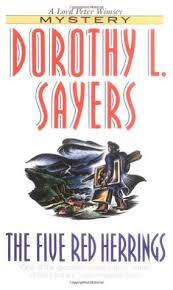
I’ve always loved this term. At least three people who read Cold Hard News remarked that they liked the fact there were clues that made them think someone else was the bad guy, or they were led for a while to believe a different motive. Red herrings! False clues. People who you think are the murderer, but turn out not to be. If you really want a full plate of red herring, I recommend Dorothy L. Sayers’ The Five Red Herrings. It’s got a train schedule time-table plot that I never could untangle, but the red herrings are delicious.
QUESTIONS THAT NEED ANSWERING
Why is he acting like that? What did she take from the cupboard when Rupert left the room? Who killed that guy, anyway? Why? Things will happen and they won’t immediately be explained. This is different from the inference gap. These are BIG questions. As a reader, I’m not a plot person. When I read a mystery, I let the plot wash over me. If I figure it out before the end of the book, the writer didn’t work hard enough. But these questions are what builds the plot. I’ve probably read Sayers’ Murder Must Advertise seven or eight times, and I’m still not exactly sure how the plot does what it does. It’s not her, it’s me. I love it anyway. There’s one part involving an advertisement in a newspaper that could be interpreted as a double entendre, so someone at the advertising agency changes it, unwittingly throwing off the bad guys’ whole scheme. Like the red herrings, it’s delicious.
QUESTIONS ANSWERED
There’s something most writers — the good ones anyway — do that’s called playing fair with the reader. That’s you! This means that there must be enough clues salted through the book that the average reader has a shot at figuring things out. The murderer, in other words, can’t be the uncle from Pittsburgh who’s been living at a downtown hotel killing off his family and the reader never sees or hears about him until the last page.
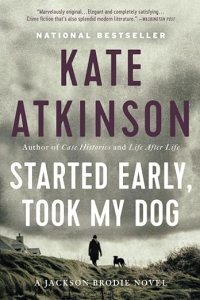 COINCIDENCE
COINCIDENCE
Yeah, there’ll be some coincidences. Some crazy ones. It’s how mysteries roll. Unlike real life, the mystery has to get solved, and sometimes you need one or two good coincidences to tie things together. The best writers keep them to a minimum and there’s an unwritten rule that big ones that solve the crime are a no-no. The better the writer, the more the rule can be broken. For instance, Kate Atkinson’s books are loaded with coincidences and they are wonderful and fantastic. I recommend any of the Jackson Brodie series. My favorite is. When Will There be Good News? A title I’d steal if she didn’t already have it. I also love Started Early, Took My Dog. Not just for the great titles, but for the books themselves. I would marry those books if that were a thing. They’re not really plot-heavy, they’re character heavy. Good characters and what they do are what make the best plots.
‘THREE TIMES WE’VE CROSSED PATHS, MR. BOND’
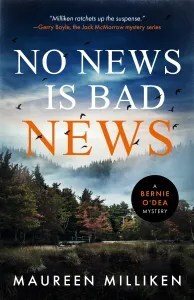 While characters are important, there shouldn’t be any who don’t play a role in the book whether it’s plot, character development, tone. Extraneous characters are a distraction. They’re not red herrings (otherwise they’d have a plot role), they’re not inference gap tools (otherwise they’d turn out to not be extraneous). A friend of mine calls it the Goldfinger rule (I don’t know if he coined it or someone else did, but it’s genius.) From the James Bond movie Goldfinger: “Three times we’ve crossed paths, Mr. Bond. Once is happenstance, twice is coincidence, but three times is enemy action.” In mystery writing, it establishes the person. I like my friend’s rule so much I’m going to write a whole separate blog post about it soon. [Note from 2024: Another promise broken, dear reader. I never did. Maybe I will soon.] For now, I’ll say that every character in the book should mean something. In No News is Bad News I didn’t bring back some favorites from Cold Hard News because they didn’t have a role to play and there was no point in trotting them across the stage just so the audience could applaud with recognition. “Oh look! There’s Bev Dulac!” Then, 200 pages later, “Hey, what happened to Bev? She was there on page 27 and we haven’t seen her since.”
While characters are important, there shouldn’t be any who don’t play a role in the book whether it’s plot, character development, tone. Extraneous characters are a distraction. They’re not red herrings (otherwise they’d have a plot role), they’re not inference gap tools (otherwise they’d turn out to not be extraneous). A friend of mine calls it the Goldfinger rule (I don’t know if he coined it or someone else did, but it’s genius.) From the James Bond movie Goldfinger: “Three times we’ve crossed paths, Mr. Bond. Once is happenstance, twice is coincidence, but three times is enemy action.” In mystery writing, it establishes the person. I like my friend’s rule so much I’m going to write a whole separate blog post about it soon. [Note from 2024: Another promise broken, dear reader. I never did. Maybe I will soon.] For now, I’ll say that every character in the book should mean something. In No News is Bad News I didn’t bring back some favorites from Cold Hard News because they didn’t have a role to play and there was no point in trotting them across the stage just so the audience could applaud with recognition. “Oh look! There’s Bev Dulac!” Then, 200 pages later, “Hey, what happened to Bev? She was there on page 27 and we haven’t seen her since.”
DANGER! DANGER!
You will like a character. That character will be put in jeopardy. If it’s a series and he or she is the protagonist, it’ll all end up okay (most of the time). You’ll be worried anyway, because that’s the fun of the mystery novel. This will happen, in a series, more to this beloved protagonist than will happen to the entire population of an average American city in a lifetime. A normal person would be dead or in a rubber room. But the plucky protagonist will keep bouncing along and you will accept it because you are reading a mystery series.
YOU WILL PAY ATTENTION
This is important with any book, but this blog post is about mysteries. I’ve had people email me or accost me in parking lots (it’s true!) wanting to argue plot points. I know I’ve read my book a gazillion times and most others have only read them once, but most of their questions are answered in the book. They just missed it. Don’t speed read it, dear reader. Don’t surf your phone with one hand and read with the other. If the writer is going to make sure she adheres to the Goldfinger rule, the least you can do is pay attention. I don’t mean to sound snarky, I’m just asking you to hold up your end of the deal. [Another note from 2024: After three published books, this has become one of my biggest peeves when it comes to reader complaints. I can’t force you to pay attention to what you’re reading, but please do, since it’s a mystery with a lot of moving parts. #yourewelcome].
THEY DON’T HAVE TO BE TOO GRISLY, SCARY OR [INSERT WORD HERE]
This is a new one for 2024. I’ve had many many people since my first mystery was published almost eight years ago tell me they don’t read mysteries because they’re too grisly. Or they’re too scary. Or they’re too something else. As I said at the beginning, everyone has their own tastes. One thing I will say about mysteries though, is they span a huge range, from cozy to hard-boiled to terrorific. Don’t lump us all into one category, because that’s not how we roll. If you’re mystery-curious, ask your librarian, local bookseller or the World Wide Web for recommendations of mysteries that aren’t the thing you don’t read mysteries because of. You will likely find one you like.
LACK OF SLEEP
You will vow before you go to bed to just read one chapter. Then you’ll look at the clock and it’s 3 a.m. and you’ve read 15 chapters because you just had to find out what was going to happen next.
And that, dear reader, is all you really need to know about how to read a mystery.
January 18, 2024
While Waiting for Inspiration
Kate Flora: Sometimes I hit January 2nd raring to go, with a brain full of a story that 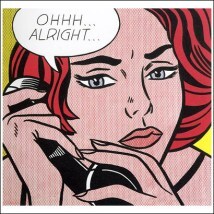 demands to be written. One year, it was two stories, and I had to make one wait while I wrote the other. This year? Nada. The urge to write a new story hasn’t arrive yet. So what does a write do when she void in the inspiration suit? Pull old stories out of the drawer and fiddle with them.
demands to be written. One year, it was two stories, and I had to make one wait while I wrote the other. This year? Nada. The urge to write a new story hasn’t arrive yet. So what does a write do when she void in the inspiration suit? Pull old stories out of the drawer and fiddle with them.
Actually, when I wasn’t busy in December with all those holiday things we do, I was trying to cut five thousand words out of a manuscript so an editor would agree to read it. The book was too long, but there weren’t chapters or even scenes that we easy to cut, so instead I found myself going word by word, cutting single words or occasional sentences to reach a word count under 100,000. It was brutal, and very slow going, and spilled over into January, so I didn’t have to face the idea void until the second week.
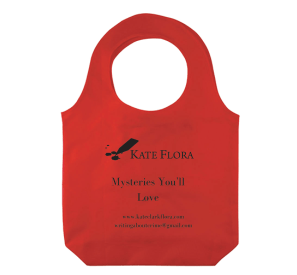 But now I am facing it, and honestly, rereading and editing old books is kind of fun. The first week I spent rereading a book called Memorial Acts. In truth, the working title for the book which is about how the mother and daughter in a military family let the loss of two husbands and fathers shape their lives, was called Blow Jobs for America. Not a title that’s easy to send to an agent, though these days it just might sell. The book isn’t a murder, although someone is murdered in the book. It would probably be called women’s fiction, or women’s fiction with elements of romance. It was fun to go back and reread it and decide whether I still liked the story. I do. It was only after I’d finished reading and doing a little light editing that I woke up one morning thinking: But in the first chapter, Amy is too unpleasant. I need to have her “save the cat.”
But now I am facing it, and honestly, rereading and editing old books is kind of fun. The first week I spent rereading a book called Memorial Acts. In truth, the working title for the book which is about how the mother and daughter in a military family let the loss of two husbands and fathers shape their lives, was called Blow Jobs for America. Not a title that’s easy to send to an agent, though these days it just might sell. The book isn’t a murder, although someone is murdered in the book. It would probably be called women’s fiction, or women’s fiction with elements of romance. It was fun to go back and reread it and decide whether I still liked the story. I do. It was only after I’d finished reading and doing a little light editing that I woke up one morning thinking: But in the first chapter, Amy is too unpleasant. I need to have her “save the cat.”
Maybe some people are unfamiliar with the term, “save the cat.” It comes from a book on screenwriting by Blake Snyder, subtitled: The Last Book on Screenwriting You’ll Ever Need.
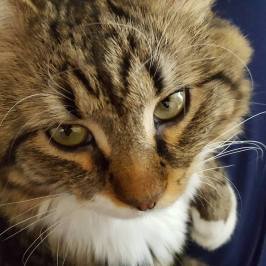 The “Save the Cat” scene is the scene where we meet the hero and the hero does something—like saving a cat—that defines who he is and makes us, the audience, like him. So in the book, Amy, who is tired and grungy after a long plane trip and a difficult business meeting, gets in a grubby cab and when the driver does something careless, she yells at him. And then, not liking herself for her attitude and behavior, apologies, the drive apologizes, and she learns that he’s distracted because he has to drive the cab to make money while his wife is in the hospital having their baby. Grumpy changes to compassionate, a connection is made, and Amy is revealed in a better light.
The “Save the Cat” scene is the scene where we meet the hero and the hero does something—like saving a cat—that defines who he is and makes us, the audience, like him. So in the book, Amy, who is tired and grungy after a long plane trip and a difficult business meeting, gets in a grubby cab and when the driver does something careless, she yells at him. And then, not liking herself for her attitude and behavior, apologies, the drive apologizes, and she learns that he’s distracted because he has to drive the cab to make money while his wife is in the hospital having their baby. Grumpy changes to compassionate, a connection is made, and Amy is revealed in a better light.
Amy actually saves a lot of cats in the course of the book.
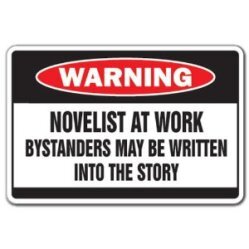 Rereading the book also reminded me of this: I wanted the book to open with Amy discovering that she’s gotten the wrong the suitcase at the airport and the one she’s brought home holds some very odd items. Curious about what to put in that suitcase, I asked my FB friends for suggestions. What I ended up putting in that suitcase, instead of the cute flannel pjs with cats she expected to find, were a bloody clown suit large enough to fit a tall man, an old photograph, and a bundle of antique silver wrapped in a silk nightgown. That set the stage for the man who shows up with her suitcase, and what his story is.
Rereading the book also reminded me of this: I wanted the book to open with Amy discovering that she’s gotten the wrong the suitcase at the airport and the one she’s brought home holds some very odd items. Curious about what to put in that suitcase, I asked my FB friends for suggestions. What I ended up putting in that suitcase, instead of the cute flannel pjs with cats she expected to find, were a bloody clown suit large enough to fit a tall man, an old photograph, and a bundle of antique silver wrapped in a silk nightgown. That set the stage for the man who shows up with her suitcase, and what his story is.
Revisiting an old manuscript is rather like meeting friends I haven’t seen in a while. I’m reminded, as I read about Amy, and her mother, Angel, and Luke, the man with the peculiar items in his suitcase, what it was like to spend time with them. It was definitely a book where my characters took charge and told me how the story was going to go. That doesn’t always happen and when it does, it’s both scary and fascinating.
 Books can begin in so many different ways. With a character. With an event. With a scene that makes me wonder why these people are in this situation. Sometimes with a character who raises the question: who is she and what’s her story? The whys are always a significant driver of story. Memorial Acts didn’t begin with Amy in her taxi. It began with a prologue about a cop holding a dying man in his arms on a rainy night in a filthy alley. That scene is still in the book but not until much later. But it was that scene—the feeling of the night, the power holding a dying man had over the cop who found him—and my immense curiosity about what the story was, that led to a novel.
Books can begin in so many different ways. With a character. With an event. With a scene that makes me wonder why these people are in this situation. Sometimes with a character who raises the question: who is she and what’s her story? The whys are always a significant driver of story. Memorial Acts didn’t begin with Amy in her taxi. It began with a prologue about a cop holding a dying man in his arms on a rainy night in a filthy alley. That scene is still in the book but not until much later. But it was that scene—the feeling of the night, the power holding a dying man had over the cop who found him—and my immense curiosity about what the story was, that led to a novel.
I’ve moved on from Memorial Acts to a book that still needs a title, about a political campaign and a girl who discovers that one of the candidates for president is her father. One campaign wants her to disappear; the other to use her, so she’s on the run from both of them. This book started because I was thinking about the strengths that Title XI, and women being able to be tough and competitive, give to today’s female athletes. Then the rest of the story, in which she reads her mother’s diary and learns about her mother’s affair, and her mother’s life when her mother was her age, followed. Unfortunately, the book 116K and needs a serious pruning. We shall see how that goes.
Who knows. Maybe rereading these old books will spark something and a brand new book will emerge.
And yes, I need to reread Save the Cat and learn how to write a log line.
Lea Wait's Blog
- Lea Wait's profile
- 509 followers



